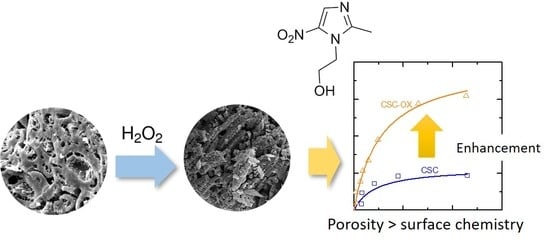Modifying Nanoporous Carbon through Hydrogen Peroxide Oxidation for Removal of Metronidazole Antibiotics from Simulated Wastewater
Abstract
Share and Cite
Ariyanto, T.; Sarwendah, R.A.G.; Amimmal, Y.M.N.; Laksmana, W.T.; Prasetyo, I. Modifying Nanoporous Carbon through Hydrogen Peroxide Oxidation for Removal of Metronidazole Antibiotics from Simulated Wastewater. Processes 2019, 7, 835. https://doi.org/10.3390/pr7110835
Ariyanto T, Sarwendah RAG, Amimmal YMN, Laksmana WT, Prasetyo I. Modifying Nanoporous Carbon through Hydrogen Peroxide Oxidation for Removal of Metronidazole Antibiotics from Simulated Wastewater. Processes. 2019; 7(11):835. https://doi.org/10.3390/pr7110835
Chicago/Turabian StyleAriyanto, Teguh, Rut Aprillia Galuh Sarwendah, Yove Maulana Novirdaus Amimmal, William Teja Laksmana, and Imam Prasetyo. 2019. "Modifying Nanoporous Carbon through Hydrogen Peroxide Oxidation for Removal of Metronidazole Antibiotics from Simulated Wastewater" Processes 7, no. 11: 835. https://doi.org/10.3390/pr7110835
APA StyleAriyanto, T., Sarwendah, R. A. G., Amimmal, Y. M. N., Laksmana, W. T., & Prasetyo, I. (2019). Modifying Nanoporous Carbon through Hydrogen Peroxide Oxidation for Removal of Metronidazole Antibiotics from Simulated Wastewater. Processes, 7(11), 835. https://doi.org/10.3390/pr7110835






